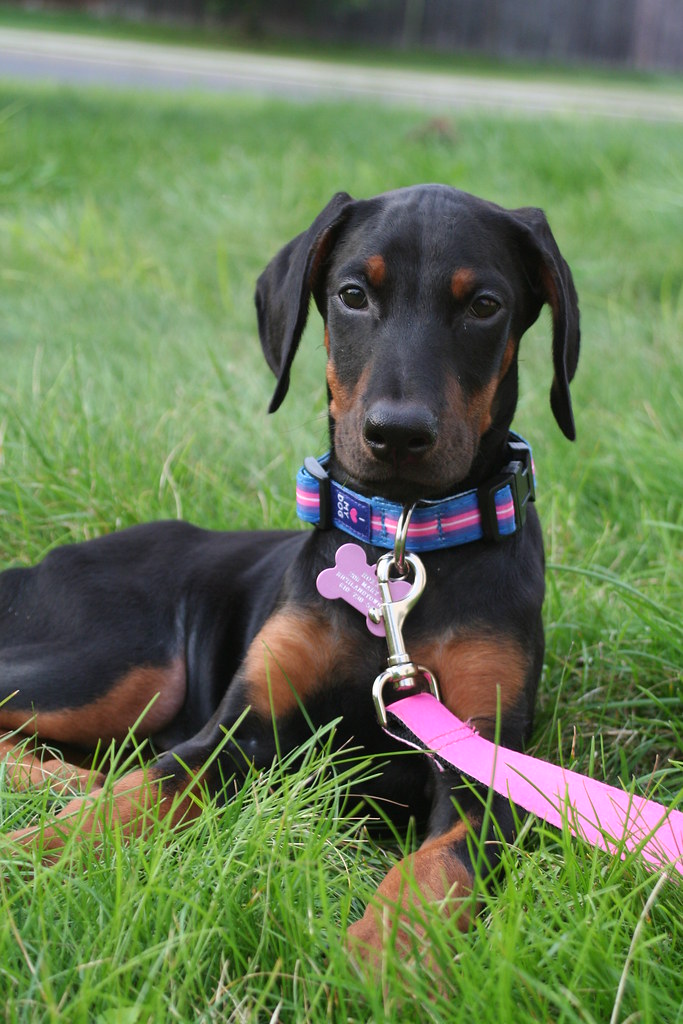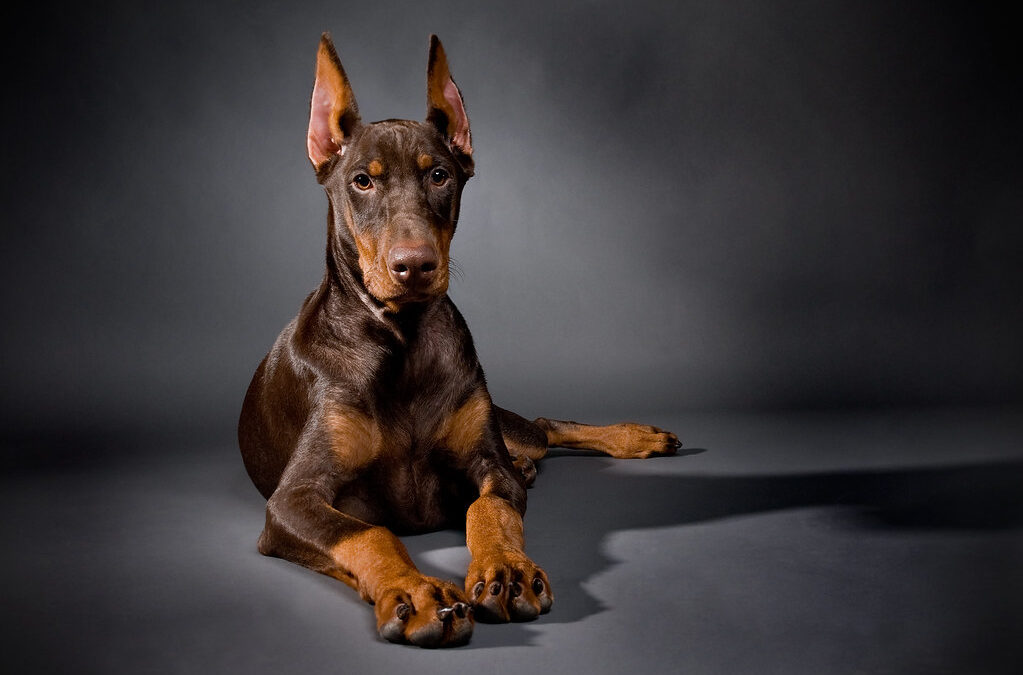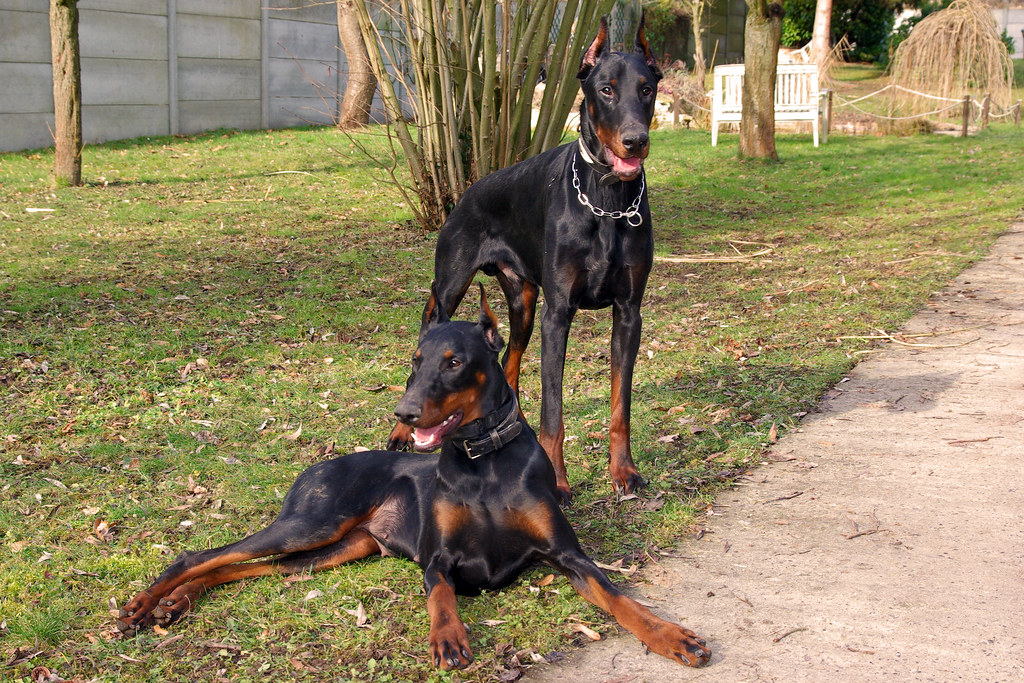Doberman Pinscher Basic Breed Information
Name: Doberman Pinscher
Breed Age: Recognized by the AKC in 1908
Average Size: 26-28” for males, 24-26” for females
Average Weight: 75-100lbs for males, 60-90lbs for females
Life Expectancy: 10-12 years
Coat Variations: Black & Rust, Blue & Rust, Fawn & Rust, Red & Rust
Fun Fact: The United States Marine Corps adopted the Doberman as its official war dog after the breed proved themselves on the battlefields during WWII.
*All breed information comes from the AKC website on Dobermans
Doberman Pinscher Breed History
Dobermans were originally created as guard dogs for tax collectors who had to go door-to-door to collect money. As you can imagine, this job was very dangerous despite being only part-time. A man named Karl Friedrich Louis Dobermann wanted to create a breed that would be unshakable in the face of angry constituents refusing to pay their taxes, or when facing the criminals that would target tax collectors. It is believed that Dobermans are a combination of German Shepherd for intelligence and stamina, the Rottweiler for strength, guarding ability, and coat, the German Pinscher for speed and energy, and the Weimaraner for its scenting ability. Karl Dobermann was not at all concerned about appearances for the early Dobermans, rather he selected puppies based solely on temperament and intelligence. After Karl Dobermann died in 1894, others took up the reins on Doberman Pinscher cultivation. The Manchester Terrier and Greyhound were cross-bred with the Doberman to streamline the breed and give it more speed and mobility. A man named Otto Göller founded the first Doberman club and helped set the first recorded breed standards. Göller passionately introduced Dobermans to the greater public, and even exported puppies that he bred in his personal kennels abroad.
Doberman Pinscher Strengths
- Intelligence! It can’t be stated enough that Dobermans are highly intelligent and observant
- Easy to teach
- Responsive to their humans
- Incredibly loving and devoted to their family
- Great with young children
- Only require a light brushing once a month
- Not known to drool much
- Quite adaptable to new situations and people
- Vigilant protectors
- Very, very playful

Doberman Pinscher Weaknesses
- Require lots of mental stimulation from the start
- High energy can be hard to handle if they don’t have a “job”
- They MUST be socialized as much and as quickly as possible
- Not suitable for apartments or homes with small yards
- Obedience training is more than recommended unless an owner has extensive experience with dog training
- Can quickly become destructive and hard to manage if they are not stimulated and trained properly
- These dogs are classified as a working breed, and therefore are typically not well suited to highly sedentary lifestyles
7 Common Doberman Pinscher Health Concerns:
The AKC lists these 7 conditions that Dobermans are particularly prone to. Click on the name of a health condition to read more.

Bloat
-
- The official term for this health issue is GDV complex, or gastric dilation-volvulus complex. This disease causes the dog’s stomach to fill with air. This rise in pressure cuts off the blood supply returning to the heart, and this reduction in blood volume will send the dog into shock within hours. Watch your pup for a sudden enlargement of their abdomen, coupled with retching, restlessness, excessive salivating, and a tender belly. If you suspect your dog may be at risk for this health condition, please bring them in immediately for a medical evaluation!
Hip Dysplasia
-
- Hip dysplasia is a common skeletal deformation, usually started by a dog’s genetics and exacerbated by weight, exercise, and nutrition. Hip dysplasia occurs when a dog’s hip joint, normally a ball and socket mechanism, does not develop properly. This causes the grinding of the bones in the joint, and can lead to total loss of function of the dog’s leg. Foods that help temper excessive growth can be helpful for puppies of breeds most at risk for hip dysplasia. Maintaining a healthy weight throughout the dog’s life is also crucial, as extra weight only adds more pressure to the at-risk joints. A veterinarian can also recommend joint supplements as part of a preventative treatment plan.
Dilated Cardiomyopathy
-
- According to the Doberman Pinscher Club of America, “The primary problem in Doberman DCM is within the heart muscle cell, an inability to contract normally which leads to abnormal function of the heart. To compensate for the poor contractile ability the heart dilates increasing the chamber size which in the early stages of disease will improve output of the heart (stroke volume).” Symptoms of DCM may include: shortness of breath, low appetite, coughing, fainting, and weight loss. The Doberman Pinscher Club recommends annual cardiac screenings to monitor and catch the disease in its earliest stages if it is detected.
Von Willebrand’s Disease
-
- Another common genetic disorder, Von Willebrand’s disease is characterized by an inability of the blood to clot quickly. This leads to a greatly increased bleeding time for any injury. The only way to diagnose this disease is with a genetic test that can tell if a dog is affected, just a carrier of the trait, or unaffected.
Progressive Renal Atrophy
-
- A genetic disorder characterized by progressive vision loss and eventual blindness in dogs. Currently, the only way to diagnose this disease is to have a specialist veterinary ophthalmologist examine the back of the dog’s eye to test retinal functionality. There are also a few genetic tests that can be administered to young dogs to test for the gene responsible for PRA.
Hypothyroidism
-
- A non-life-threatening disease. A dog suffering from hypothyroidism cannot produce enough of the hormone that controls their metabolism. Causes can include: a dog’s immune system attacks its thyroid glands, the thyroid glands shrank due to an unknown cause, or in very rare cases, a tumor that develops in the thyroid. The symptoms of hypothyroidism include hair loss on the dogs back half, loss of coat sheen, blackened or flaky skin, weight gain, muscle loss, frequent ear infections, cold intolerance, and a slower heart rate among other things. To diagnose this disease, a vet will have to do various blood tests on the animal.
Albinism
-
- Albinism in animals presents almost identically to albinism in humans, including white or cream-colored coats, pale or red eyes, and pink noses, lips, and eyelids. Dogs affected by albinism are at a much higher risk for extreme light sensitivity, and cancers of the skin, lips, eyes, and eyelids among other related health issues. In recent years, some breeders have tried to pass off the albino Dobermans as a “rare color variant”. This misinformation is incredibly harmful to the relative health of the breed, as it discourages breeders from selecting breeding animals that are not carriers of the albinism gene. Or worse, purposely breeding albino animals to sell to unaware buyers.
Tunga the police dog is a purebred Doberman Pinscher who started working for the Davanagere district police force when she was only a few months old. The Davanagere district is an important political and commercial district, located in the Karnataka state in India. Now 9 years old, Tunga has been credited by her handlers on the police force for helping them solve over 60 cases, 30 of which involved murders, plus numerous thefts and armed robberies. Tunga is praised for her exceptional nose and dedication to her work.
In July of 2020, Tunga was celebrated for some of her finest police work yet. She and her handlers were called to the scene when a group of men who had robbed a home nearby shot and killed one of their own and fled. Tunga arrived at the scene of the crime, took a few good sniffs, and took off running within a few minutes. She stopped briefly at a wine store, then led police to a food place before taking off again. A total of 12km later, Tunga finally stopped at a home which was later found to belong to a relative of one of the criminals. The criminal in question was inside on the phone at the time. Tunga followed this man’s scent not only to this home, but to all of the places he had stopped that evening! Tunga’s 12km run is exceptional because on average, sniffer dogs only travel roughly 3-5km while they are tracking. You’d need a pretty powerful sniffer to follow the scent for as long as Tunga did. She solved a murder and located the suspect all within 3 hours of hard police work. What an amazing pup!




